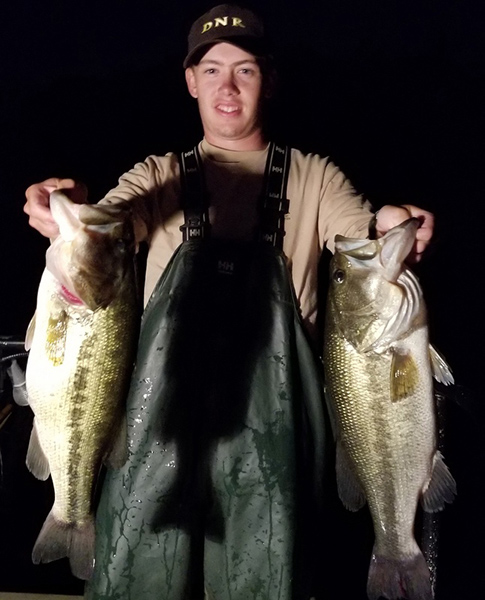 Bass Numbers Grow; Is It a Problem?
Bass Numbers Grow; Is It a Problem?
Do northern Indiana lakes have too many bass?
That’s the question that Hoosier fish managers are starting to ask and, if so, what are the consequences?
“Our surveys indicate bass numbers have doubled over the past 30 years,” said DNR bass biologist Jed Pearson. “That’s a positive thing until it upsets a balance in the fishery.”
The veteran biologist attributes the increase to bass anglers’ affinity to practice catch and release and the addition of an increased size limit years ago.
Indiana went from no size limit to 12 inches in 1990 and from 12 to 14 in 1998. The result has been a lot of bass swimming in Hoosier lakes.
That’s a good thing, right?
It is, to a point.
“What concerns us is that we’re seeing lakes that have high numbers of bass but no increase in big bass,” Pearson said. “And we know anglers like big bass.”
For example, a recent electroshocking survey at High Lake in Noble County turned up 804 bass – an incredible number based on DNR sampling methods. It’s a trend biologists are starting to see on other lakes.
“But only 16 of those were legal and only 2 were over 18 inches,” Pearson said. “If we’re getting stunted bass it’s a concern, but not a negative. We have much better bass fishing in this region that we did years ago. Maybe we need to tweak some things to make it even better.”
When bass numbers are excessive they compete for the same food and growth is stunted.
But that may not be the case. He said the lack of bigger bass on some lakes could be due to heavy harvest of fish once they hit the magical 14-inch size limit.
Pearson acknowledges that a huge percentage of anglers don’t keep the bass they catch.
“But we do know there are those who take home a limit of bass, which is perfectly legal,” he said. “What we don’t know is if harvest or slow growth is preventing us from having bigger bass in those lakes.”
He acknowledges that more thorough studying needs to be done and the DNR isn’t ready to change regulations. It does want to get a better handle on the effect of increased bass populations.
“What’s interesting is that the lakes in which we have an 18-inch size limit and 2-fish bag limit are producing plenty of bigger fish,” he said. “For example, on Shock Lake (Tri County Fish and Wildlife Area near Syracuse, Ind.), we turned up 84 bass, 7 of those were 18 inches or bigger and several were in that 15- to 17-inch range.”
He’s not insinuating all lakes should have such a limited regulation and knows that wouldn’t set well with the public.
But it is noteworthy.
“Another solution might be to put a slot limit in place that would protect mid-size fish and allow anglers to take out the smaller ones,” he said. “But states that have tried that say it doesn’t work because people are so ingrained with releasing bass they won’t keep the small ones.”
A sidelight to his observations is that the lakes with dense bass populations also have good bluegill size structure.
“Our challenge is to find a balance and provide good bluegill and bass fishing,” he said.
Bass eat bluegill, and the high number of bass keeps bluegill numbers in check and promotes faster growing ‘gills.
“It’s not clear what percentage of our lakes lack bigger fish but we are finding more and more with each new survey we do,” Pearson said. “On the other hand, we have a lot of other lakes with good bass fishing.”
Pearson said he’s only heard a few complaints from anglers about too many small bass, but it warrants a closer biological look to help the DNR get out ahead of a potential problem.
“We’re not considering any changes at this time, but we would like some public feedback as to what it is seeing or any regulation changes they’d like to propose,” Pearson added.
Anyone who has comments or suggestions on this topic or any other fish and wildlife issue can email them to the DNR at DFW@dnr.in.gov.


